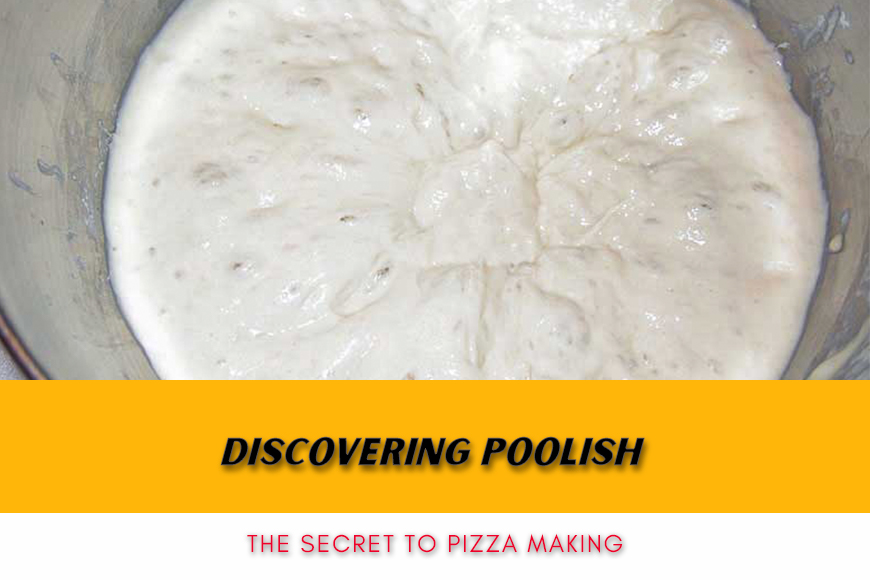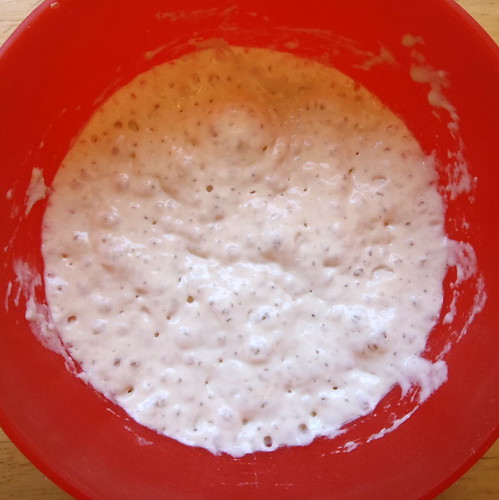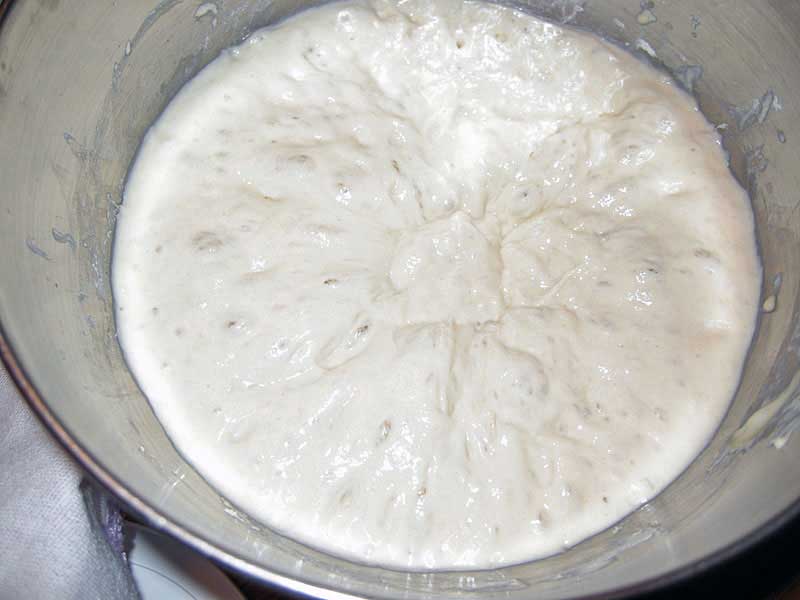
Discovering Poolish: The Secret to Pizza Making
Last updated on March 4th, 2025 at 09:03 pm
Welcome to a new deep dive of Italian Pizza Secrets into the world of preferments. Thanks to our guide “Discovering Poolish: the secret of pizza making”, we are going to explore a valid alternative to Biga, another preferment we can use to make pizza. As you know if you read this blog and follow us on Social Media, we use a lot biga for pizza. But today is time to explore Poolish, a liquid preferment often used in bread making and perfect also for pizza making. Goal of today is to understand what is Poolish and discuss the most important aspects of it.
The guide Discovering Poolish: The Secret to Pizza Making will cover the following topics:
As you will shortly read, making a pizza with poolish is not only possible but brings also several advantages. So, knowing more about this preferment for pizza is going to help you making a different pizza. Of course, before you can prepare a pizza recipe with poolish, is key to know more about what that is. Starting from the foundation is always essential to troubleshoot issues or to understand how to tune your recipe.
What is Poolish?
Let’s start with the very basic concepts. Poolish belongs to the family of preferment and is a liquid one. We define it liquid because it is always using a 100% hydration. That makes the preferment appearing indeed as liquid, or almost liquid.

Generally speaking, I think that you are perfectly aware about what a preferment is. But if not, let me use the words I used in my previous article about another, well-known and widely used preferment: biga:
When you create a dough (can be for bread or for pizza, it applies to both) you have two mixing methods: direct and indirect. The first one consists in mixing all ingredients together – following of course the right order – to create the dough. The indirect method consists of preparing an initial “dough” that uses only few ingredients called indeed pre-ferment. You let the preferment develop (or ferment) for a certain amount of hours and then you mix it with the remaining ingredients of the recipe you want to create.
If it sounds complicated I understand. But in reality is much easier than you think. Just keep reading.
Why Poolish is Used in Bread Making?
Using preferments can have very interesting effects on your bread (but also on your final pizza dough). Neverthless – as said before – you need to know exactly what you are working with before you can get the advantages we are going to discover. In Italian pizza world we mainly use two preferments: biga and poolish. The first is probably used more than the second. And in fact poolish is much more used in bread making.
Poolish helps getting an elastic yet extensible gluten mesh, a higher crust volume as well as a longer shelf-life
But why do we use Poolish in bread making in the first place? Using Poolish in a recipe helps getting an elastic yet extensible gluten mesh, a higher volume of the crust as well as a nicer final smell. Also, poolish helps in prolonging the shelf-life of the bread. However, this is true depending on how you prepare the Poolish. Differently than in biga, where amount of ingredients to use are kind of standardized, in Poolish you have several “recipes”. More on that in the next paragraph, but for now remember that the longer the fermentation of Poolish is, the stronger are the positive effects in your dough.
You may now ask if you can get the same effects using poolish in pizza making? The good news is that the answer is yes. Not only that, but from a certain point of view the management of Poolish as kind of easy. Even though less standardized like other preferments (and of course I am referring to Biga in the first place).
So, let’s see how to prepare poolish.
How Do You Make Poolish?
Poolish is a less standardized preferment than Biga. In the Essential Guide to Biga for Pizza, we went through the process of making biga where I highlighted how this preferment is well “coded”. In fact you can follow a standard process that is well described in various books especially from the master baker Giorilli. For Poolish the experience is a bit different.
First of all: you can make poolish reaching different levels of fermentation. So you can in theory prepare a poolish in just one or two hours! Or – as recommended – youc an prepare a poolish where the fermentation is much longer, up to 18 hours. The difference between a short and a long poolish is the amount of yeast that you use when mixing the ingredients. Following is a table with the amoun of yeast to use according to how long you want the fermentation to be.
Poolish Fermentation Time
| Fermentation time | Yeast % |
| 1-2 hours | 2,5-3% |
| 4-5 hours | 1,5% |
| 7-8 hours | 0,5% |
| 10-12 hours | 0,2% |
| 15-18 | 0.1% |
So let’s try to use a real example. Remember that a Poolish always requires 100% hydration. Meaning that you always use the same amount of flour and water. The only ingredients weight that changes is the yeast. Also bear in mind that the percentages in the table above refer to the usage of fresh yeast. If you use dry or instant dry yeast you may need to reduce the final amount of it by 1/3 or 1/2.
Following the guide of the table above, let’s think about a preparation of a poolish that ferments 7-8 hours. We need to use 0,5% of yeast:
Polish Example
| Ingredient | Percentage (%) | Weight (gr) |
| Flour | 100 % | 1000 gr |
| Water | 100% | 1000 gr |
| Yeast | 0,5% | 5 gr |
Now you should have a clear understanding of how to prepare poolish. But still we did not discuss about the fermentation in itself and what is important to keep in mind when making a poolish.
To prepare Poolish it is recommended to have some sourdough jars that help the fermentation. The following are my favorite:
Note that above are referral links. I may get a fee from the seller if you buy using the links. But for you there will be no additional cost.
What Are the Key Factors in Fermenting Poolish?
Let’s start with a topic that is very important in fermentation of every preferment: temperatures. To make sure that the tables I shared above are working we need to work with specific temperatures, both when finishing the mixing and during the fermentation.
First of all, the ideal poolish temperature should be between 23 and 25 Celsius degrees. Then, fermentation has to happen at a temperature of 20-22 Celsius degrees. Translated it means that if you don’t have a place in your home or laboratory with a more or less constant temperature of 20-22C, it will be hard to use this preferment. For home bakers it will be best to prepare poolish during winter, when it is easier to have a favorable environment temperature.
The second factor to observe is to understand when the poolish is ready. Of course you expect to see a rising in volume in first place. Poolish normally is doubling. But this is not enough to consider the preferment ready. The rule that you should follow is to observe the upper part of the preferment. You want to find an initial collapse in the center of poolish. When you see it, then the preferment is ready:

Another key factor for poolish is that it is not recommended to prepare the short fermentation version. If you really want to get the advantages of using poolish, you want to have a fermentation of 12 hours or more.
As temperatures are key, you better buy a good food thermometer. The best for this
Note that above are referral links. I may get a fee from the seller if you buy using the links. But for you there will be no additional cost.
How to Use Poolish in a Pizza Recipe?
Until now we discussed about Poolish preferment in general. We also said that the usage of Poolish is very much linked to bread making. However – like for biga – Poolish can definitely be used also to make pizza. It’s all about finding the right balance of how much poolish to use in pizza dough.
To answer the above question we need to think that it depends on the pizza style we are preparing in the first place. And that’s because we need to consider the high hydration of Poolish, as well as the amount of yeast that it brings. Let alone that Poolish affects the structure of our final pizza dough. In fact, as this is a preferment, we don’t have to forget that we borrow for it the ingredients that are meant to be used in the final pizza recipe. Normally you want to experiment with an amount that goes from 20% to 50% from your total pizza recipe.
So let’s once again have an example.
Our example starts with a Neapolitan pizza dough with a 20% of Poolish. The pizza dough will be hydrated at a standard 65% and you want to work with 1kg of flour in total. Taking this in consideration, for a 20% poolish we are going to borrow 200grams of flour and 200 grams of water from the final dough. Moreover, as we are preparing a Neapolitan pizza, we want to use a long poolish fermentation, to avoid to bring too much yeast in the final dough. Let’s say that we use a 10 hours poolish fermentation with 0,2% of yeast. We will end up having:
- Poolish ingredients
- Flour: 200 grams
- Water: 200 grams
- Yeast: 0.4 grams
- Final Neapolitan pizza dough:
- Flour: 800 Grams
- Water: 450 grams (remember is a 65% total hydration)
- Yeast: 0 grams
- Salt: 20 grams (assuming we use 2% of salt on the flour)
Does it make sense? We started with 1000 grams of flour and we took 200 grams for the Poolish. The rest is simple math.
What Are Some Common Mistakes to Avoid When Using Poolish?
The first mistake you want to avoid is to work with wrong temperatures. To make sure that Poolish works as expected and produces the results that we ask to this preferments, yuo need to have a way to measure its temperaturte as well as the room temperature. Remember that Poolish should be at a 23 and 25 Celsius degrees. While the room where it is maturing should be a bit lower 20-22C. So if you don’t have it yet, get a kitchen thermometer.
The above mistake leads also to a wrong fermentation. Is ts especially true that one of the most common issues with Poolish is over-fermentation. This happens when Poolish is left to ferment for too long or at an higher temeperature. The risk is to have a very sour taste and a weakened gluten structure in your pizza dough. You’ll know your Poolish is over-fermented if it seems excessively bubbly and has a strong, unpleasant smell. That is why you want to always adhere to recommended fermentation times and be mindful of the temperature of your environment.
Another mistake is to use the wrong amount of Poolish in the final recipe. We covered that already in the previous paragraph with an example of using Poolish in a Neapolitan pizza. However it is up to you to experiment if you wish. Then to keep track of your experiments, I recommend you to get your Pizza Notebook Recipe 😉
Conclusion
This article is just an introduction to Poolish for pizza. That is why I defined it as “Poolish Essentials”. In the coming weeks and month we will compare more in depth poolish vs biga and we will discover a few tips and tricks on how to prepare a perfect poolish.



